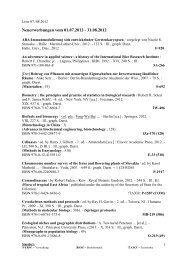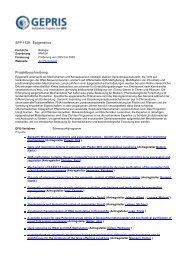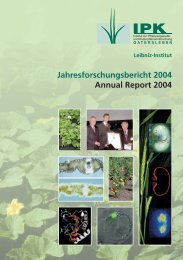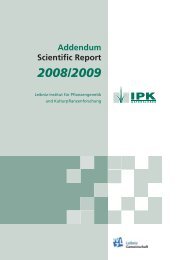Research Group - IPK Gatersleben
Research Group - IPK Gatersleben
Research Group - IPK Gatersleben
Create successful ePaper yourself
Turn your PDF publications into a flip-book with our unique Google optimized e-Paper software.
Abteilung Genbank/Department of Genebank<br />
Programme:<br />
Taxonomy and Evolution<br />
<strong>Research</strong> <strong>Group</strong>:<br />
Experimental Taxonomy<br />
Head: Dr. Frank Blattner<br />
Scientists<br />
<strong>IPK</strong> financed<br />
Baier, Christina (0,5 P)<br />
Ekhvaia, Jana (0,5 Annex, 01.09.-30.11. 007)<br />
Jakob, Sabine, Dr. (P, till 18.06. 007)<br />
Köhnen, Ines (0,5 P, since 01.07. 007)<br />
Grant Positions<br />
Köhnen, Ines (0, 5 DFG, till 30.06. 007)<br />
Nürk, Nicolay (0,5 DFG, since 01.09. 007)<br />
Pleines, Thekla (0,5 DFG)<br />
Visiting Scientists<br />
Achigan-Dako, Enoch (DAAD)<br />
Bachmann, Konrad, Prof. (self-financed)<br />
Esfeld, Korinna (SMNC, 16.04.-11.05. 007;<br />
University of Heidelberg, 8.08.- 8.09. 007)<br />
Kotseruba, Violetta (DAAD, 0.09.-19.11. 007;<br />
self-financed, 0.11.- 6.1 . 007)<br />
Goals<br />
Development and application of molecular marker<br />
methods and the identification, characterisation and<br />
phylogenetic classification of crops and their wild relatives.<br />
Experimental studies to link molecular markers and<br />
phylogenetic data with taxonomically and agronomically<br />
significant characters, and to analyse plant–environment<br />
interdependency on the species level.<br />
<strong>Research</strong> Report<br />
The major aim of the group is to understand mechanisms<br />
resulting in speciation processes in specific plant groups.<br />
This involves the study of the distribution of species, populations<br />
and genotypes in time and space together with<br />
the analysis of character state changes involved in environmental<br />
adaptation and reproductive isolation. These<br />
characters (e.g., abiotic stress tolerance) influence the eco-<br />
50<br />
logical niches of organisms and are often also important<br />
agronomic traits. Thus, the study of naturally occurring<br />
genetic diversity in wild species could show ways to breed<br />
improved crops for changing environmental conditions.<br />
On the basis of a large data set of chloroplast haplotypes<br />
and their relationships, we analyse monophyletic species<br />
groups of Hordeum in a phylogeographic context. We<br />
include climate models to infer past and present distribution<br />
areas of species together with genetic data to<br />
analyse the history of species and species groups. In the<br />
Mediterranean Hordeum marinum group these analyses<br />
revealed the existence of two good species instead of a<br />
single species with two subspecies, and proved clear ecological<br />
differences between the diploid and tetraploid<br />
cytotypes of H. gussoneanum (Jakob et al. 007). Up to<br />
now, no convincing phylogeny could be obtained for the<br />
closely related New World species of Hordeum, as these<br />
species evolved only during the last two million years,<br />
resulting in minute genetic differences among the taxa.<br />
To solve this problem, we initiated an AFLP study of all<br />
diploid species from the Americas, which should result<br />
in better phylogenetic hypotheses for this species group<br />
(T. Pleines, F. Blattner).<br />
In a greenhouse experiment, where we grow three closely<br />
related sympatric species of Hordeum, we simulate niche<br />
differences along salt and drought gradients. This experiment<br />
combines a competition approach with different<br />
soil parameters with a common garden experiment.<br />
First results demonstrate that some species-specific differences<br />
in their ecological niche use (salt vs. drought stress)<br />
are inheritable and are maintained in the greenhouse<br />
(T. Pleines, S. Jakob, F. Blattner). For these species, gene<br />
expression experiments under different stress conditions<br />
were also conducted to analyse the genetic response to<br />
salt, drought and cold stress. These analyses complement<br />
the greenhouse experiments. Thus, we get information<br />
on niche use and the genes involved in niche adaptation<br />
(T. Pleines, F. Blattner).<br />
Cucurbitaceae provide an important group of crop species<br />
in Western African countries. They are used as oil seeds,<br />
fruits, and vegetable. In several expeditions E. Achigan-<br />
Dako was able to collect the species diversity in the phylogeographic<br />
regions of West Africa, ranging from the<br />
tropical rainforest of the southern part to the Sahel zone<br />
in the north. For this group, we are now analysing the<br />
biodiversity present in West Africa. Morphometric analyses<br />
and genome size measurements with flow cytometry,<br />
in conjunction with phylogenetic and phylogeographic<br />
analyses are currently undertaken to identify new species<br />
and subspecies and get insights in domestication of native<br />
crops of this region (E. Achigan-Dako, F. Blattner).<br />
Species of the Euphorbiaceae genus Macaranga are important<br />
Southeast Asian pioneer shrubs and trees of<br />
areas where the rainforest was freshly logged. Many of













